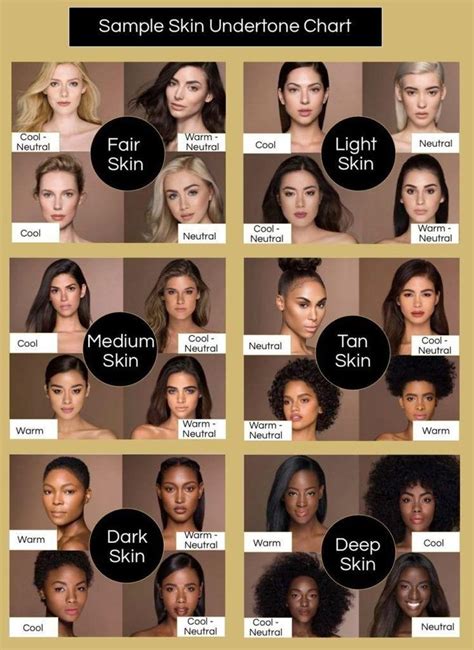Navigating the labyrinth of hair colors can be daunting, especially when considering your unique skin tone. To simplify your search, we present an indispensable guide to finding the most flattering shades that will enhance your natural features.

Skin Tone Characteristics
Step 1: Determine Your Undertone
Your skin’s undertone, whether warm, cool, or neutral, plays a crucial role in color selection. To determine yours:
- Warm undertones: Veins appear greenish or olive; skin tends to tan easily.
- Cool undertones: Veins appear blue or purple; skin may burn more easily than tan.
- Neutral undertones: Veins exhibit a mix of green and blue; skin is adaptable to both warm and cool colors.
Step 2: Identify Your Skin Type
- Fair skin: Light, often with a pinkish hue.
- Medium skin: Yellowish, olive, or beige undertones.
- Dark skin: Deep tones ranging from golden brown to rich chocolate.
Best Hair Color for Skin Tone Chart
Fair Skin
- Cool undertones: Ashy blonds, icy reds, violet blacks
- Warm undertones: Honey blonds, golden browns, auburn reds
- Neutral undertones: Most blonde, brown, and red shades
Medium Skin
- Cool undertones: Dark chocolates, mahogany reds, honey blonds
- Warm undertones: Caramel blonds, copper reds, deep chocolates
- Neutral undertones: Any shade of blonde, brown, or red
Dark Skin
- Cool undertones: Blue-blacks, espresso browns, cool reds
- Warm undertones: Warm reds, golden honey, deep chocolates
- Neutral undertones: All shades of brown, burgundy, and black
Common Mistakes to Avoid
- Choosing a shade too far from your natural color, which can create a harsh or artificial appearance.
- Ignoring your undertone, which can lead to a color that washes you out or clashes with your skin.
- Over-processing your hair, which can damage its health and compromise its vibrancy.
Why Hair Color Matters
- Enhance facial features: The right hair color can draw attention to your eyes, lips, and cheekbones.
- Complement skin tone: A flattering shade can brighten your complexion and make skin imperfections less noticeable.
- Express personality: Hair color can convey a wide range of emotions, from sophistication to edginess.
Benefits of Finding the Perfect Hair Color
- Increased confidence: A hair color that complements your skin tone can boost your self-esteem and make you feel more attractive.
- Improved appearance: The right shade can create a more polished and youthful look.
- Protection against UV damage: Darker hair colors offer natural protection against sun damage.
Pros and Cons of Different Hair Colors
Blonde:
- Pros: Brightens complexion, youthful appearance
- Cons: Requires more upkeep, can cause damage
Brunette:
- Pros: Versatile, natural-looking, conceals gray
- Cons: May wash out fair skin tones
Red:
- Pros: Bold, attention-grabbing, suits warm undertones
- Cons: Prone to fading, can be high maintenance
Black:
- Pros: Sophisticated, slimming, creates a dramatic effect
- Cons: May be too harsh for fair skin tones
Table 1: Hair Color Ideas for Fair Skin
| Skin Tone | Undertones | Flattering Hair Colors |
|---|---|---|
| Fair | Cool | Ashy blonde, icy red, violet black |
| Fair | Warm | Honey blonde, golden brown, auburn red |
| Fair | Neutral | Most shades of blonde, brown, and red |
Table 2: Hair Color Ideas for Medium Skin
| Skin Tone | Undertones | Flattering Hair Colors |
|---|---|---|
| Medium | Cool | Dark chocolate, mahogany red, honey blonde |
| Medium | Warm | Caramel blonde, copper red, deep chocolate |
| Medium | Neutral | Any shade of blonde, brown, or red |
Table 3: Hair Color Ideas for Dark Skin
| Skin Tone | Undertones | Flattering Hair Colors |
|---|---|---|
| Dark | Cool | Blue-black, espresso brown, cool red |
| Dark | Warm | Warm red, golden honey, deep chocolate |
| Dark | Neutral | All shades of brown, burgundy, and black |
Table 4: Common Hair Color Mistakes and How to Avoid Them
| Mistake | How to Avoid |
|---|---|
| Choosing a shade too far from your natural color | Opt for shades that are within two to three levels of your natural color. |
| Ignoring your undertone | Identify your undertone and choose shades that complement it. |
| Over-processing your hair | Follow proper hair care routines and use color-protecting products. |
